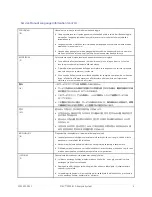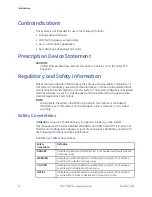
Introduction
When using stainless steel or silver electrodes, a defibrillator discharge current may
cause the electrodes to retain a residual charge causing a polarization or DC offset
voltage. This electrode polarization blocks acquisition of the ECG signal. To avoid this
condition, if there is a situation where a defibrillation procedure might be necessary,
use non-polarizing electrodes (which do not form a DC offset voltage when subjected
to a DC current) such as silver/silver-chloride types.
If you use polarizing electrodes, GE Healthcare recommends disconnecting the
leadwires from the patient before delivering the shock.
Electrode defibrillation recovery is the ability of the electrode to allow the ECG trace to
return after defibrillation. GE Healthcare recommends using non-polarizing disposable
electrodes with defibrillation recovery ratings as specified in AAMI EC12 5.2.2.4. AAMI
EC12 requires that the polarization potential of an electrode pair does not exceed 100
mV 5 seconds after a defibrillation discharge.
Refer to the supplies and accessories reference guide for this system for a list of
approved electrodes.
Accuracy of Input Signal Reproduction
• Overall System Error meets AAMI EC11 3.2.7.1 requirements. Overall System Error is
between or within ±5% or ±40 µV, whichever is greater.
• Frequency Response meets AAMI EC11 3.2.7.2 requirements, using testing methods
A and D. Frequency response is between or within ±10% between 0.67 and 40 Hz
and b0 and -10% for 20 ms, 1.5 mV triangular input.
Modulating Effects in Digital Systems
This device uses digital sampling techniques that may produce some variation in
amplitudes of Q, R, and/or S waves from one heart beat to the next, which may be
particularly noticeable in pediatric recordings. If you observe this phenomenon,
be aware that the origin of amplitude variations is not entirely physiological. For
measuring voltages of Q, R, and S waves, GE Healthcare advises using the QRS
complexes with the largest deflection of the particular waves.
EMI/EMC/RF Safety Information
This system is designed and tested to comply with applicable regulations regarding
EMC and must be installed and put into service according to the EMC information
stated in the Electromagnetic Compatibility appendix of the Service and/or Operator’s
manual. Changes or modifications to this system not expressly approved by GE
Healthcare could cause EMC issues with this or other equipment.
Before installing or using the device or system, be aware of the proximity of known RF
sources, such as the following:
• Radio and TV stations
• Portable and mobile RF communication devices (cell phones, two-way radios)
• X-ray, CT, or MRI devices
18
MAC™ 2000 ECG Analysis System
2053535-003C
Summary of Contents for MAC 2000
Page 41: ...Product Overview 2053535 003C MAC 2000 ECG Analysis System 41 ...
Page 134: ...Maintenance 134 MAC 2000 ECG Analysis System 2053535 003C ...
Page 160: ...Parts List 160 MAC 2000 ECG Analysis System 2053535 003C ...
Page 182: ...182 MAC 2000 ECG Analysis System 2053535 003C ...
Page 183: ......















































